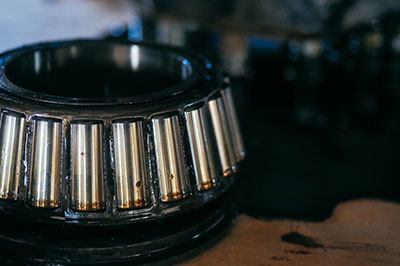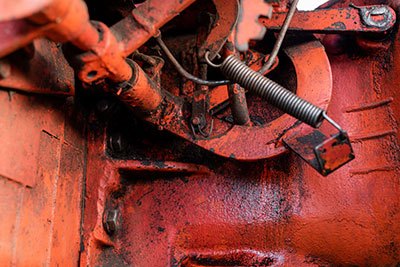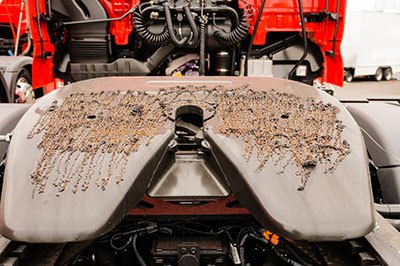When it comes to maintaining your tractor’s lubricant system, you’ll often hear advice on switching up greases. But is this something you’re allowed to do?
While doing your maintenance, the best way to ensure proper performance without complications is by following the manufacturer’s instructions. You’ll understand when grease substitutions may be necessary.
In this guide for agriculture workers and farmers, we’ll go over everything about switching greases in high-torque machines and ensuring the best grease compatibility.
Take Away Key Points:
- Switching the base oil additives in machinery is simple and quick
- You can switch the oil by following the manual
- You must use the right oil for the optimal performance of your machines
Table of Contents
- Changing greases in high-torque machinery
- Can you switch the grease in your machines?
- When should you switch the grease in your tractor?
- How to switch the grease in your tractor?
- How can you know which one can you use and how to replace different types of grease?
- How can you make grease Zerks accept the new grease in your tractor?
- How can you make the grease fittings accept the new grease in your tractor?
- Will the grease gun work properly with the new grease in your tractor?
- Fixing a blocked grease Zerk to accept the new grease
- FAQs
- Summary
Changing greases in high-torque machinery
If you use certain grease but notice that your tractor might have an issue, maybe it’s time to change it for better operating conditions.
So, you can refer to the guide below to ensure you know how to select the proper grease for your machinery.
Can you switch the grease in your machines?

Yes, you can switch the grease in your tractor. Greasing the zerks with proper grease on a tractor is an important part of regular maintenance and should be done regularly to ensure that the tractor is running optimally.
To change the grease, you will need to locate all of the grease fittings on the tractor and use a grease gun to inject new lubricants into grease points. It’s important to use the correct type of grease (synthetic oils, lithium base oils, aluminum complex components, and similar additives) for your tractor.
Using the wrong type of chemicals could cause damage, corrosion, or reduce the performance of the equipment. Additionally, it’s important to make sure all of the old lubrication has been removed before adding the new lubrication for better friction.
When should you switch the grease in your tractor?
When it comes to greasing your tractor, timing is everything.
Knowing when to switch grease in your tractor can help you maintain the best performance and extend the life of your machine. So, the right grease ensures all the grease fittings, grease points, bearings, spring types, and other commonly greased components work fine and offer good quality.
The National Lubrication Grease Institute (NLGI) gives tractor grease nine grades, ranging from 000 to 6. Grade 000 is a high-performance grease that should be used for extreme-pressure applications, while grade 6 is a general-purpose grease suitable for most applications.
Depending on the type of work you are doing with your tractor, you may need to switch between these grades of grease to ensure optimal performance and protection from wear and tear, rust, and corrosion, and ensure the best friction of the equipment.
For example, if you are using your tractor for heavy-duty tasks such as plowing or tilling, then you should use a higher grade of grease like grade 000 or 00. These grades are designed to withstand extreme pressure and provide superior lubrication in tough conditions.
On the other hand, if you are using your equipment for lighter tasks such as mowing or hauling hay bales, then you can use a lower grade of grease like grade 2 or 3.
It’s also important to remember that different types of machines require different types of greases. For instance, some tractors use lithium-base oils, multi-purpose oils, or synthetic oil types complex greases while others use polyurea greases. Make sure to check the manufacturer’s recommendations before switching out any greases in your tractor.
Finally, it’s important to regularly check the condition of your grease and replace it when necessary. Over time, even the highest quality lubrication will break down due to heat and friction so it’s important to keep an eye on them and replace them when needed.
How to switch the grease in your tractor?
Switching the grease in a tractor is an important part of preventive maintenance. It’s best to completely remove the old grease, ensure there is no excessive wear and tear, and start over with the new grease for safety reasons. To do this, you’ll need a grease gun and the right type of grease for most tractors.
First, make sure that the area around the fittings is clean and free from dirt or debris. Then, attach the nozzle of your grease gun to the fittings and pump it until you see fresh grease coming out. Once you’re done, wipe away any excess grease with a rag or paper towel.
It’s also important to remember to check your tractor’s manual for specific instructions on how often to switch out greasing additives and what types of greases are recommended for your model.
Depending on the type of tractor and its usage, you should change the grease additives every 6 months to a year. Greasing will ensure that your tractor is properly greased and running smoothly. You will prevent rust, wear and tear, and similar damage to all parts – joints, bearings, bushings, tubes, pins, thinner tube types, loader, etc.
For example, if you are using your tractor for agricultural purposes, you should change the greases every 6 months or after 250 hours of use. If you are using your tractor for light-duty tasks such as mowing lawns or plowing snow, then you should change the grease at least once a year or after 500 hours of use.
How can you know which one can you use and how to replace different types of grease?

Tractors require lubrication to function properly and safely. There are a variety of different types of grease that can be used in tractors, including:
- mineral oils (paraffinic base oil and naphthenic base oil),
- synthetic base oil (PAO, ester, PAG, and alkylbenzenes),
- natural base oil (vegetable), and
- high-performance (silicones and fluorinated fluids).
The type of greasing you use will depend on the specific needs of your tractor.
When it comes to replacing grease in your tractor, it is important to choose the right type for your machine. To do this, you should first consult the owner’s manual for your tractor which will provide information about the recommended type of grease for your model.
You may also want to consider using a multi-purpose grease that is designed to work with a wide range of machines. Additionally, some tractors may require a specific type of greases such as molybdenum disulfide or moly grease.
Once you have chosen the right type of grease for your tractor, you should follow the instructions provided in the owner’s manual for replacing it. This typically involves draining out any old grease from the system before adding new lubricant. It is also important to ensure that all components are clean before applying new lubricant as dirt or debris can cause damage to moving parts.
How can you make grease Zerks accept the new grease in your tractor?
If you have a tractor, you may have encountered the problem of grease Zerks not accepting new grease. This can be a frustrating issue, but there are some steps you can take to get your Zerks working properly again.
The first step is to try using a little heat on the Zerk fittings. This will help loosen up any blockages that might be preventing the new grease from entering the bearings.
You should also make sure that your grease gun is working properly and that it can squirt out enough grease into the Zerk. If this doesn’t work, then you may need to replace the Zerk itself or use a different type of fitting such as an Alemite or Zirk Zert Zerck Zerk Nipple Fitting.
Another option is to use a locking grease gun coupler, which makes it easier and faster to get the new grease into the Zerk without having to worry about blockages or other issues.
Finally, if all else fails, you can always take apart the fitting and clean out any debris that might be blocking it before reassembling it and trying again with new grease.
How can you make the grease fittings accept the new grease in your tractor?
This can be done by first cleaning out any old or clogged grease from the fittings and preventing the leak. You can do this with a wire brush, a small screwdriver, or a special tool called a grease cleaner.
Once the old grease has been removed, you should apply some fresh lubricant to the bearings and then use a hand-held grease gun to pump in the new grease until it is full. Make sure to check all of the fittings on your tractor regularly and change them if they become too worn or damaged.
Will the grease gun work properly with the new grease in your tractor?
Yes, a grease gun can be used to properly lubricate your tractor with the new grease. Grease guns are designed to dispense lubricants in small amounts, allowing for precise application of the grease to the bearing, loader, bushings, joints ad pins, thickeners, and other greasing components.
They come in manual, pneumatic, and electric varieties and can handle pressures up to 500 psi. It is important to select the right type of grease gun for your particular application.
For instance, if you are working on a farm tractor, you may need a heavy-duty model that can withstand higher pressures and temperatures and work with most greases and oil additives.
Additionally, it is important to choose the right type of fittings for your grease gun so that it fits securely onto the grease nipple on your tractor. You might also need two guns and two greases if your tractor requires so for mixed or separate greasing additives.
Fixing a blocked grease Zerk to accept the new grease

If you’re looking to fix a blocked grease zerk in your tractor, there are a few steps you can take. First, try taking the zerk off and digging around with a wire or welding rod to clear any clogs. You can also apply heat to the fitting or bearing and attach a grease gun to push out the old grease additives.
Additionally, you can spray mineral spirits into the fitting or bearing and suck or blow out any clogs. Finally, if all else fails, you may need to replace the zerk altogether to ensure there won’t be pressure for different load operations.
No matter what method you choose, it’s important to make sure that your tractor is properly lubricated with fresh grease for it to run smoothly and efficiently.
FAQs
Where can I grease my tractor?
You can grease it at home, in your garage for instance if you have the proper equipment to do so. You can watch different videos to help you with the process. If not, visit your local tractor service center and get ti done there.
What is the best grease for a John Deere tractor?
The best grease for a John Deere tractor is Grease-Gard Premium Plus. It is a multi-purpose HD Lithium complex grease used by John Deere for initial factory-fill lubrication of U-joints and axle components.
It protects against wear, rust, and corrosion, making it ideal for heavy-duty applications. Grease-Gard Premium Plus is available in 400g VC67009X004 from Ben Burgess or the John Deere website.
How do you clean grease off a tractor?
The most effective methods are to power wash as much as possible, scrape, and spray on a degreaser such as Mean Green Degreaser right out of the bottle or dab on some with a paintbrush. Then scrub and scrape to remove the grease.
Alternatively, you can spray on some Dawn dish soap and let it set for a while before scrubbing with a stiff brush. To make it easier to remove the grease, you can also spray it down with tranny oil or used engine oil first.
For tougher jobs, consider using a pressure washer with heated water to get the big chunks off before tackling the rest of the job.
What grease for a tractor loader?
The most commonly recommended grease is AirTec Lube-Shuttle® LI400 Extreme Ceramic Multi-Purpose, which meets and/or exceeds the requirements for compact and subcompact tractors.
Other popular greases include Lucas Red N Tacky, Mobil, Shell, Pennzoil, John Deere multi-purpose grease, and High-Performance Moly-Lithium All-Purpose Heavy Duty.
What size grease fitting for Kubota tractor?
Generally, most Kubota models use 6mm or 1/4 inch fittings. However, some larger machines may require larger 8mm or 9mm fittings. To find out what size your tractor requires, it’s best to refer to the owner’s manual or contact a local service center for more information.
Summary
Greasing a tractor is an important maintenance job that extends the life of the machine.
Replacing grease regularly can help reduce wear and tear, improve fuel efficiency, and prevent costly repairs.
It’s quick and easy to switch out the grease whenever needed. It takes no more than five minutes and no special tools are required.
